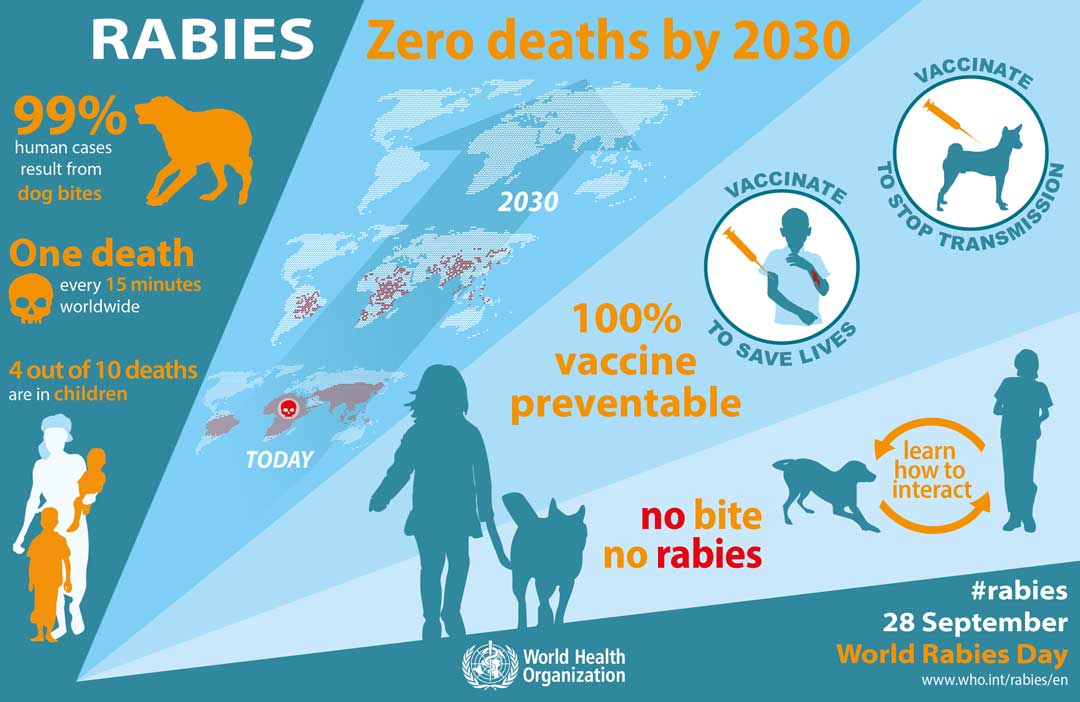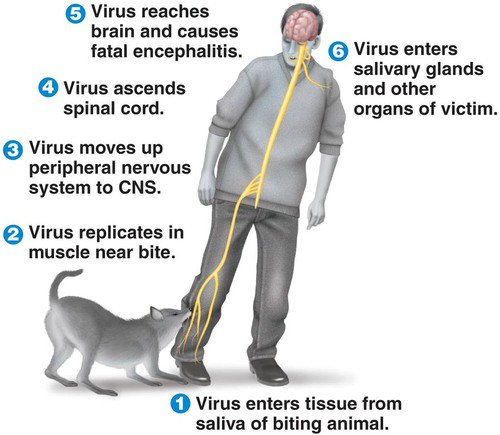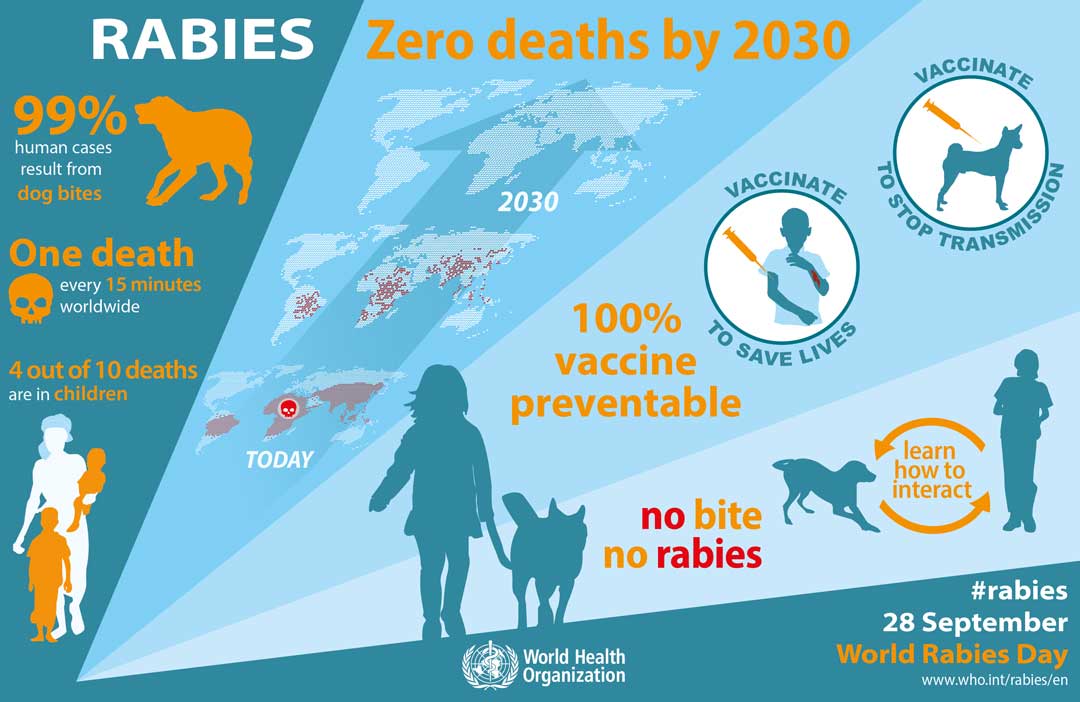Rabies is a viral disease that attacks the brain and the centre nervous system (CNS) of mammals and also humans. Once the symptoms of rabies are present, death is almost certain. Rabies is a worldwide issue. There is an estimated 59,000 human deaths from rabies annually all over the world and the number of animals including pets and wild animals dying from rabies is immeasurable. Fortunately, rabies is a preventable disease. It can be avoided through proper vaccination.

Causes & transmission
Rabies is caused by the Rabies virus, a species of the Lyssavirus genus. Humans, mammals and vertebrates can serve as its hosts. Rabies virus doesn’t survive long outside the host’s body. Rabies virus can be transmitted from an infected animal to other animals or humans via saliva. Rabies is commonly spread through a bite, a scratch, or licking an open wound where the saliva of the infected animal (rabid animal) comes in direct contact with the animals or person’s mucous membrane.
All mammals can carry the rabies virus, but it is more common in mammals such as dogs, cats, raccoons, foxes, jackals, wolves, coyotes and cats. Small rodents like squirrels, mice, rabbits, chipmunks and hamsters rarely get infected with this virus. In Europe, foxes are the main carrier of rabies, while skunks, foxes, raccoons and bats are the primary sources of infection in North America. In Asia, Latin America, and Africa the main rabies carrier is not wildlife animals but more towards stray dogs. Countries like Australia, New Zealand, the United Kingdom, Japan, Singapore, Papua New Guinea and the Pacific Islands has been declared rabies-free.
Dog to human infection of rabies

How to prevent rabies?
Since there is no cure for rabies, prevention is absolutely crucial.
To prevent rabies,
- Vaccinate your pet: Visit your veterinarian regularly and make sure the rabies vaccination is up-to -date to provide maximum protection to your pets.
- Keep your pets indoor to prevent them from making direct contact with wild animals.
- Don’t leave your pets’ food or garbage outside as this can attract wild animals.
- Report stray or wild animals that behave strangely to the local authorities as these animals could be a potential rabies carrier.
- Spay or neuter your pet: Cats or dogs tend to escape home due to the urge to mate. Spay or neuter your pets to keep them safe at home and thus reduce the risk of rabies exposure.
- Never keep wild animals as pet.
- Supervise your dog when they are outside. If you let your dog roam free in the yard, make sure you keep an eye on it.
- If your pet has been bitten by a domestic animal, stray animal or wild animal, consult your vet immediately.
How to tell if your pet dog has rabies?
The period between the bite and the onset of symptoms is known as incubation period. The incubation period is usually less than 6 months, although the symptoms might occur sooner or later. The symptoms may appear earlier depending on the severity of bite and the site of injection. The virus will reach the brain or the central nervous system quicker if the bite is near the brain or the spinal cord. Following a bite from a rabid animal, the bitten animal may go through one or all of the phrases below.
Prodomal phase
Prodomal phase is the first phase once the rabies virus reaches the brain. This phase lasts for a few days. In this phase, the animal may demonstrate significant behavioral changes such as nervousness, anxiety, and fearness. An animal that is normally friendly may become aggressive towards people and other animals. On the other hand, an animal that is normally aggressive may become unusually friendly or docile. A fever may also be present in this phase. Most dogs or cats will often progress to the furious phase, the paralytic phase or the combination of the two after the Prodomal phase.
Furious phase
In this phase, the animal will become hypersensitive to external stimuli such as light and sound. Furious phase is also known as ‘mad dog syndrome’ because in this phase, the dog or other pets will become restless, aggressive and may viciously attack humans, animals and even inanimate objects. If it was caged, it will chew iron bars until they injure themselves badly. The animal then will become progressively disoriented, begin to develop seizure and it will die eventually.
Paralytic phase
Some animals may develop a third phase called paralytic phase or ‘dumb’ phase. This is a phase where the nerve in the head and throat of the animals becomes paralyzed. As a result, animals will have difficulty in swallowing and will be paralyzed in most body parts and foam will come out from the mouth. In general, most of the animals will enter paralytic phase after the Prodomal phase. The bodies of the animals will become weaker from time to time and they will eventually enter a coma state and die.
Rabies risk by country

How to diagnose rabies?
In animals, diagnosis of rabies can be done by detecting the rabies virus in any part of the affected brain. This test can only be done post mortem (after death). That means the process requires the animal to be euthanized.
Is there a cure for rabies?
There is no cure for rabies once the symptoms appear. If your pet has been exposed to rabies or bitten by a rabid animal, it needs to be quarantined for observation. Since rabies is a serious public health threat, pets who are suspected of having rabies must be euthanized.
Note: September 28 is World Rabies Day, which promotes the information, prevention, and elimination of the disease.

,
